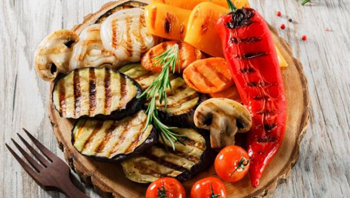Jan 4: Whether you make formal New Year's resolutions or not, the changing of the calendar often leads to contemplating what changes we might like to see in our lives. On the nutrition front, these are my top five picks for habits worth cultivating in 2017.
 Creating and serving even the simplest of meals is a profound way of caring for yourself and your loved ones. Homemade meals tend to be more healthful than ones you purchase, because when you cook from scratch, you know exactly what you're eating. That makes it much easier to eat in a way that aligns with your health goals.
Creating and serving even the simplest of meals is a profound way of caring for yourself and your loved ones. Homemade meals tend to be more healthful than ones you purchase, because when you cook from scratch, you know exactly what you're eating. That makes it much easier to eat in a way that aligns with your health goals.
Think that cooking is difficult or time-consuming? It can be, but it doesn't have to be. Even inexperienced home cooks can do wonderful things when they learn a few core skills: A few ways to cook vegetables; the ingredients for a simple vinaigrette; how to cook a pot of beans or whole grains; what to do with a piece of meat or fish, or a block of tofu or tempeh.
Nail down a few basics, assemble a small collection of condiments and seasonings that appeal to your taste buds and you're set. For inspiration, look for cookbooks and food blogs that embrace real-world "let's get dinner on the table" cooking with short ingredient lists that emphasize easily available fresh foods and pantry staples. Save any "project" cooking for the weekends.
Consider why you eat
Sure, you eat when you're hungry, but what are the other reasons you eat? Boredom? Stress? Loneliness? Anxiety? Many people use food to meet needs that food simply wasn't meant to meet. When you find yourself reaching for food or mindlessly browsing the contents of your refrigerator, get in the habit of asking yourself, "Am I hungry?" If the answer is "No," ask yourself what you are expecting food to do for you in that moment. Usually, there are better, more meaningful ways of entertaining or soothing yourself.
Reduce added sugars
According to the 2015-2020 Dietary Guidelines for Americans, it's difficult to get enough of the nutrients we need for good health without exceeding our calorie needs if we get more than 10 percent of our total daily calories from added sugar. The average American does get more than that, especially children, teens and young adults.
Added sugars are different from the natural sugars found in vegetables, fruits, grains, beans and dairy products. Added sugars, which include white sugar or other calorie-containing sweeteners, are highly refined from their original source and add calories without nutrients. Beverages are the biggest source of added sugars, followed by desserts and snack foods, but sugar is added to many prepared foods - including salad dressings and frozen meals - another reason home cooking is better for health.
Eat more plants
If you make one change to your eating habits for 2017, a great choice would be to eat more whole plant foods: vegetables, fruit, whole grains, beans and legumes, nuts and seeds, herbs and spices. Simply put, adopting a plant-based diet is one of the best moves you can make for your health if you want to make your meals more nutrient-rich and reduce your risk of heart disease, Type 2 diabetes, cancer and other chronic diseases.
The good news is that plant-based diets can take many forms, from vegan to vegetarian to flexitarian to omnivore. The common denominator is that they put plant foods at the center of your plate. If you also choose to eat animal-based foods (meat, poultry, fish, eggs and dairy), they play smaller, supporting roles. While the benefits of a plant-based diet come from eating a variety of plant foods, you can't go wrong by making vegetables the star. They are packed with vitamins, minerals and phytonutrients - compounds that reduce chronic inflammation and disease risk - while being lower in calories than other foods.
Let go of rigid rules
Although it's hard to go wrong with eating plenty of plants and minimizing a reliance on highly processed foods, the fact is that there's no single perfect eating plan. A nutritious diet allows for flexibility and shifts over time to suit your tastes and nutritional needs. Trying to find and follow a "perfect" eating plan is not only an exercise in futility, but it also often leads to all-or-nothing thinking: You're either perfect or you're a failure. This can lead to feelings of shame, and shame is a lousy motivator for positive change. Perfection is the enemy of progress.
If you have a history of all-or-nothingism, why not try something new this year: Start small, start today and keep moving forward. Pick one or two areas to focus on - adding more vegetables to lunch and dinner, bumping up protein at breakfast, eating regularly instead of skipping meals and curbing mindless snacking are a few favorites - then add another only when you feel solid in your new habits.





Comments
Add new comment